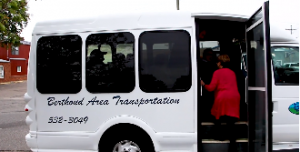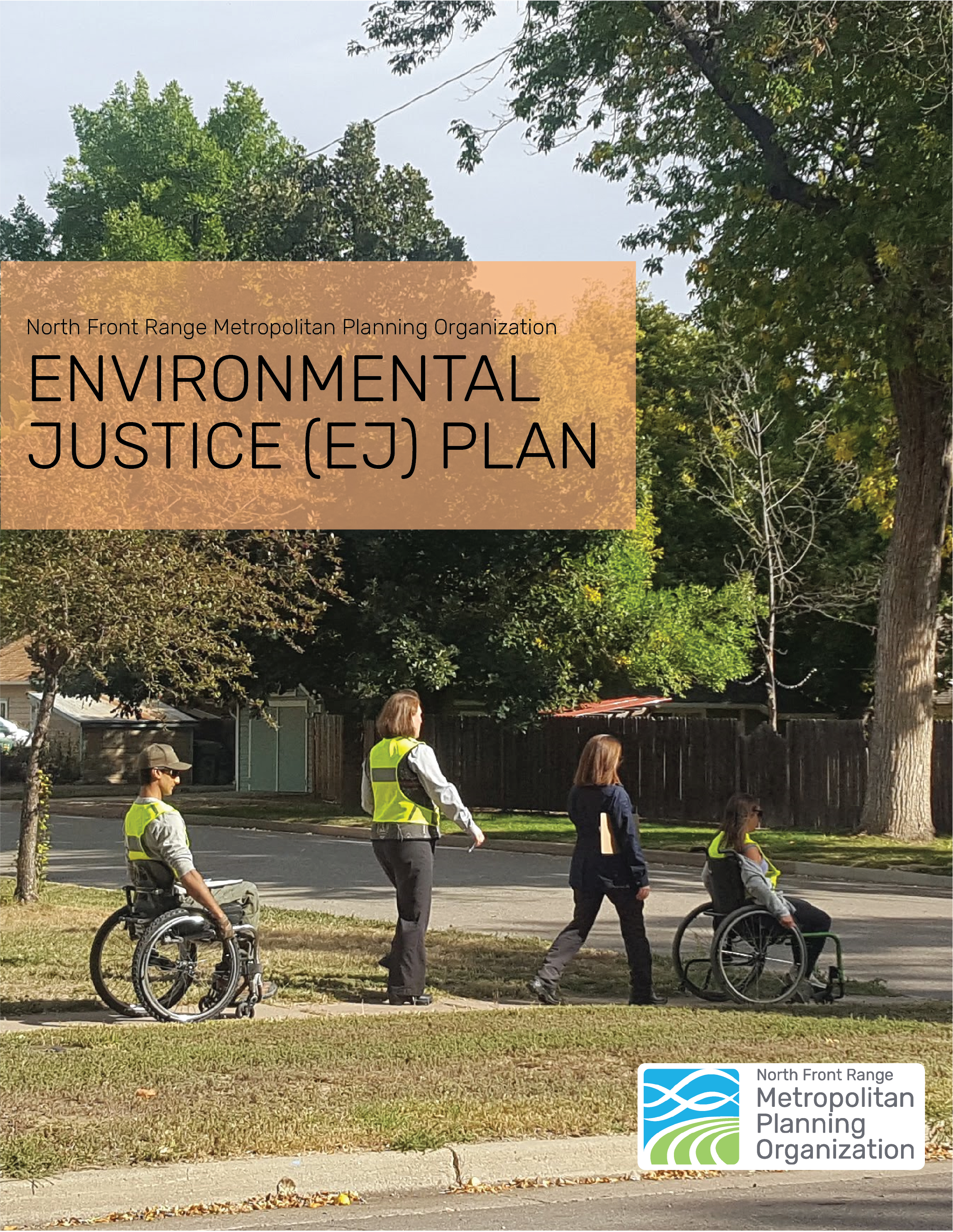What does Environmental Justice mean?

The NFRMPO is expanding Environmental Justice (EJ) considerations in its transportation planning and programming processes as part of the new EJ Plan. EJ, at its core, is ensuring disadvantaged populations do not face higher and more adverse impacts of public programs or projects than the rest of the population. Throughout history, low income and minority populations have endured discrimination, been excluded from the decision-making process, and have often faced more neighborhood and localized impacts, worse air quality, and fewer services.
There are three major principles of EJ:
- Avoid, minimize, or mitigate disproportionately high and adverse human health and environmental effects.
- Ensure the full and fair participation by all potentially affected communities in the transportation decision-making process.
- Prevent the denial of, reduction in, or significant delay in the receipt of benefits by minority and low-income populations.
What does “minority” or “low income” actually mean?
Guidance from the US Department of Transportation (DOT) and the Colorado DOT (CDOT) define these populations based on information collected by the US Census Bureau.
- Low Income – Household income is at or below the Department of Health and Human Services (HHS) poverty guidelines.
- Low income population – Any readily identifiable group of low-income persons who live in geographic proximity.
- Minority – Populations including Black, Hispanic or Latin, Asian American, American Indian and Alaskan Native, and/or Native Hawaiian or Pacific Islander as self-identified in the Census.
- Minority population – Any readily identifiable group of minority persons who live in geographic proximity.
In the NFRMPO region, data about income and minority status is analyzed to figure out a regional average. Areas with percentages higher than the regional average for either or both populations are considered EJ.
What does EJ look like in the NFRMPO region now?
To date, EJ analysis has occurred in some NFRMPO programs, like the Transportation Improvement Program (TIP) and Regional Transportation Plan (RTP). The EJ Plan addresses more areas to incorporate EJ and equity principles, best practices for local communities, and the consideration of additional populations which have faced hardships. Expanding the agency’s EJ policy, including more residents, and hearing more diverse voices will help the NFRMPO better serve Northern Colorado.
Additional Equity Considerations
Additional guideance from the United States and State of Colorado governments have been enacted to continue to address equity and ensure the benefits of investments are shared and burdens dispersed equally. NFRMPO Staff have created a resource identifying this guideance through the Equity Resources ArcGis StoryMap. The StoryMap outlines the guideance from the implementing agency, how it affects the NFRMPO, and where relevant communities are within the NFRMPO region. An overview of the leading federal and state initiatives are outlined below:
Justice 40
The Justice40 initiative was created in 2021 by Executive Order 14008, Tackling the Climate Crisis at Home and Abroad. Justice40 sets a goal of 40 percent of the benefits of certain federal investments flowing to disadvantaged communities. “Through Justice40, the United States Department of Transportation (USDOT) will work to increase affordable transportation options, that connect Americans to good-paying jobs, fight climate change, and improve access to resources and quality of life in communities in every state and territory in the country. The initiative allows USDOT to identify and prioritize projects that benefit rural, suburban, tribal, and urban communities facing barriers to affordable, equitable, reliable, and safe transportation.
Through Justice40, USDOT will also assess the negative impacts of transportation projects and systems on disadvantaged communities and will consider if local community leaders have been consulted in a meaningful way during the project’s development.”5 Justice40 census tracts are determined using demographic and environmental data to reflect disadvantage. Justice40 Disadvantaged Communities are identified based on an index of five component areas: transportation insecurity, environmental burden, social vulnerability, health vulnerability, and climate and disaster risk. Each of these components are summed into an Overall Score. A census tract will be considered disadvantaged if the overall index score places it in the 65th percentile or higher of all US census tracts. More information about the Justice40 initiative can be found on the Justice40 USDOT website.
Disproportionately Impacted (DI) Community
Disproportionately Impacted (DI) communities were established through Colorado House Bill (HB) 21- 1266: Environmental Justice Disproportionate Impacted Community, which was passed in 2021 and revised under HB 23-1233 in 2023. Colorado law defines a DI community as census block groups where:
- More than 40 percent of the population are low-income (meaning that median household income is at or below 200 percent of the federal poverty line)
- 50 percent of the households are housing cost-burdened (meaning that a household spends more than 30 percent of its income on housing costs like rent or a mortgage)
- 40 percent of the population are people of color (including all people who do not identify as non-Hispanic white)
- 20 percent of households are linguistically isolated (meaning that all members of a household that are 14 years old or older have difficulty with speaking English)
- Census block groups that experience higher rates of cumulative impacts, which is represented by an EnviroScreen Score (Percentile) above 80.
The EnviroScreen Score is calculated using the 35 indicators which are grouped into two broad categories: Health & Social Factors and Pollution & Climate Burden. More information about the EnviroScreen indicators and a mapping tool created to view DI Communities in Colorado can be found at https://cdphe.colorado.gov/enviroscreen.
Equity Index
To better reflect transportation needs in the region, NFRMPO Staff created the Equity Index, a consolidated mapping index of the three leading equity initiatives. View the Equity Index section of the StoryMap for more information including the mapped communities.
EJ Plan

2021 Environmental Justice (EJ) Plan
The EJ Plan was adopted on April 1, 2021 to create a framework for better integrating EJ and equity throughout the NFRMPO’s work. The EJ Plan includes:
- Analysis of access to the decision-making process across the region
- Identification of partnerships and engagement strategies
- Clearly defined benefits and burdens that fit our local and regional context
- Consideration of additional EJ populations, including those with above average rates of limited English proficiency (LEP), older adults, individuals with disabilities (ambulatory, self-care, independent living, hearing, vision, or cognitive difficulties), and zero-car households
- Recommended actions to improve EJ and equity considerations in transportation planning
The EJ Plan serves as a toolkit for NFRMPO staff, local agencies, and other partners. NFRMPO Staff will work with stakeholder groups such as the Community Advisory Committee (CAC) to implement the recommendations from the EJ Plan.
What are some EJ Best Practices from the NFRMPO region?
NFRMPO staff have met with and continue to meet with stakeholders around the region, learning about what local governments have been doing to increase access to the local planning and programming processes.
- During 2015, Greeley Evans Transit (GET) redesigned its transit network. Behind the scenes, GET staff compared the new bus routes to low income and minority areas to identify any adverse or undue burden. Some bus routes were slightly modified accordingly.
- Fort Collins set aside mini-grants for Community Partners during its City Plan update, partnering with local nonprofits and advocacy agencies to get more feedback and input from low income, minority, senior, and Limited English Proficiency (LEP) populations. Mini-grant funds were used for things like designing, planning, and implementing engagement events. Further, Community Partners received facilitation training and assistance in translating materials. Overall, around 30 meetings were held throughout Fort Collins, reaching hundreds of participants.
- The Larimer County Department of Health and Environment’s Built Environment Program has integrated the Language Justice model into its trainings and programming. Language Justice is the belief all people should be able to participate regardless of their native language. This has involved having simultaneous interpretation to allow all people in the room to participate in real time.
Get Involved
Get involved in the NFRMPO process by checking out our Public Involvement page.
For more information on Environmental Justice efforts at the NFRMPO, please email staff@nfrmpo.org.
